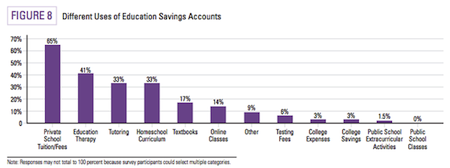Amanda Howard was speechless. Sitting on the couch with her son, Nathan, she was agape when he pointed to a picture in a book and asked an otherwise nondescript question: “What’s that?”
Amanda was shocked because Nathan had uttered only a few words in the 6 years of his young life. Nathan was on the spectrum for autism, and the couple’s early attempts to help their son by sending him to a developmental preschool had proved unsuccessful.
But in 2011, the Howards applied for one of Arizona’s Education Savings Accounts. With an account, public funds are deposited in a private bank account under parents’ control, and families such as the Howards can use the accounts for education expenses such as education therapy, private school tuition, textbooks, and college tuition.
Nathan is one of 761 children using an account this year, the third school year since Arizona lawmakers enacted the law. Student enrollment has seen a dramatic increase from 2011, when only 75 children applied for accounts to start the 2011-12 academic year.
The success has not gone unnoticed. “Some parents of modest means are surprised to discover that the education savings accounts put private school within reach,” wrote Fernanda Santos and Motoko Rich in the New York Times. Lawmakers in Florida, Iowa, Montana, and Utah have introduced legislation to replicate Arizona’s program.
Despite the increased attention, parents and lawmakers had little information on who was using the accounts, what decisions parents were making with the funds, whether parents were satisfied with their choices, and if participants had recommendations for improving the accounts.
In survey results that the Friedman Foundation for Educational Choice released today, evidence indicates that education savings account parents are very satisfied with their new options. “Schooling Satisfaction: Arizona Parents’ Opinions on Using Education Savings Accounts,” which I co-authored with Jason Bedrick of the Cato Institute, found that all of the parents surveyed reported some level of satisfaction with savings accounts, while only 43 percent of families reported any level of satisfaction with their previous public school.

True, these parents self-selected into the accounts, so we should expect that they would be happier because it was their decision to participate. However, it’s worth noting the implications of the finding that some of the respondents were “very satisfied” with their previous public school. Because all of the parents report some level of satisfaction with the accounts, this means that no matter their satisfaction level with their previous pubic school, all of the families are satisfied with their new choices.
The survey also found that parents with children across different grade levels and with varying special needs are using the accounts for a wide range of services including braille and assistive technology, swimming therapy, and classes at the Arizona Science Center. The only students using the accounts when the survey was conducted were students with special needs, but children from failing schools or adopted from the state foster care system, along with children in active-duty military families, are eligible this year—approximately 1 in 5 Arizona public school children.

Parents have flexibility with the accounts, and they are taking advantage of their options: 65 percent of respondents reported using account funds for private school tuition; 33 percent used their accounts for homeschool curriculum; 33 percent used funds to hire a tutor; 41 percent purchased education therapies; 17 percent used the accounts to buy textbooks; and 14 percent used the funds for online classes.
Critically, the survey finds that 27 percent of respondents did not use any of the funds for private school tuition. This undermines the Arizona teachers union’s claim that the accounts are the same as school vouchers. The Arizona Supreme Court ruled that vouchers violated the state constitution in 2009, and the union and state school boards’ association filed suit against education savings accounts shortly after Gov. Jan Brewer signed them into law. The survey results highlight the differences between a savings account and a voucher.
The Arizona Court of Appeals ruled last week that the accounts do not violate state constitutional provisions against using public funds for private or religious schools. In a unanimous decision, Judge Jon W. Thompson wrote, “Where ESA funds are spent depends solely upon how parents choose to educate their children. Eligible school children may choose to remain in public school, attend a religious school, or a nonreligious private school. They may also use the funds for educational therapies, tutoring services, online learning programs and other curricula, or even at a postsecondary institution…. The ESA does not limit the choices extended to families but expands the options to meet the individual needs of children.”
The Howards found services to help Nathan with his speech delay and a private school that specializes in helping children with autism. “Today he is speaking in full sentences and answers questions with very few echolalia responses,” Amanda said in 2012. “He is always asking questions, something he never did until a few months after [using an Education Savings Account].”
As reform ideas expand from school choice to educational choice—not just where a child learns but how they learn—more research is needed on the accounts to determine how a menu of educational choices affects student achievement and parent satisfaction over a longer time horizon. Researchers and policymakers should follow the accounts’ outcomes in order to make measured adjustments to student flexibility and state oversight.
-Jonathan Butcher
Jonathan Butcher is Education Director at the Goldwater Institute, which designed education savings accounts in 2005.


